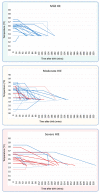The Impact of Time to Initiate Therapeutic Hypothermia on Short-Term Neurological Outcomes in Neonates with Hypoxic-Ischemic Encephalopathy
- PMID: 38929265
- PMCID: PMC11201975
- DOI: 10.3390/children11060686
The Impact of Time to Initiate Therapeutic Hypothermia on Short-Term Neurological Outcomes in Neonates with Hypoxic-Ischemic Encephalopathy
Abstract
Background: Therapeutic hypothermia is the standard treatment for neonates with hypoxic-ischemic encephalopathy. Preclinical evidence indicates that the time to initiate therapeutic hypothermia correlates with its therapeutic success. This study aims to explore whether there is a correlation between the early initiation of therapeutic hypothermia and improved short-term neurological outcomes in cooled asphyxiated newborns.
Methods: A retrospective analysis was conducted, involving 68 neonates from two different neonatal intensive care units. The impact of time to initiate treatment, time to reach the target temperature, and time between initiation and target temperature was correlated with short-term outcomes on MRI.
Results: We did not find a significant difference between outcomes regarding the time to start treatment and the time to achieve the target temperature. Interestingly, neonates with a poor outcome were treated on average earlier than neonates with a favorable outcome but required more time to reach the target temperature. Additionally, the study results did not support the hypothesis that a shorter time to initiate treatment would lead to shorter times to achieve the target temperature.
Conclusion: Based on our findings, it is recommended to prioritize a thorough evaluation of neonatal encephalopathy before initiating therapeutic hypothermia. Early initiation of treatment should be balanced with the time required for precise assessment to ensure better outcomes.
Keywords: newborn; outcome; perinatal asphyxia; therapeutic hypothermia; treatment start.
Conflict of interest statement
The authors declare no conflict of interest.
Figures

Similar articles
-
Hypothermia therapy for newborns with hypoxic ischemic encephalopathy.J Pediatr (Rio J). 2015 Nov-Dec;91(6 Suppl 1):S78-83. doi: 10.1016/j.jped.2015.07.004. Epub 2015 Sep 4. J Pediatr (Rio J). 2015. PMID: 26354871 Review.
-
Brain Temperature Is Increased During the First Days of Life in Asphyxiated Newborns: Developing Brain Injury Despite Hypothermia Treatment.AJNR Am J Neuroradiol. 2017 Nov;38(11):2180-2186. doi: 10.3174/ajnr.A5350. Epub 2017 Aug 31. AJNR Am J Neuroradiol. 2017. PMID: 28860214 Free PMC article.
-
Feasibility and Safety of Controlled Active Hypothermia Treatment During Transport in Neonates With Hypoxic-Ischemic Encephalopathy.Pediatr Crit Care Med. 2017 Dec;18(12):1159-1165. doi: 10.1097/PCC.0000000000001339. Pediatr Crit Care Med. 2017. PMID: 28938291
-
Active cooling temperature required to achieve therapeutic hypothermia correlates with short-term outcome in neonatal hypoxic-ischaemic encephalopathy.J Physiol. 2020 Jan;598(2):415-424. doi: 10.1113/JP278790. Epub 2020 Jan 2. J Physiol. 2020. PMID: 31777079
-
Current Practice of Therapeutic Hypothermia for Mild Hypoxic Ischemic Encephalopathy.J Child Neurol. 2019 Jun;34(7):402-409. doi: 10.1177/0883073819828625. Epub 2019 Mar 22. J Child Neurol. 2019. PMID: 30898007
References
-
- Robertsson Grossmann K., Eriksson Westblad M., Blennow M., Lindström K. Outcome at early school age and adolescence after hypothermia-treated hypoxic-ischaemic encephalopathy: An observational, population-based study. Arch. Dis. Child.-Fetal Neonatal Ed. 2023;108:295–301. doi: 10.1136/archdischild-2022-324418. - DOI - PMC - PubMed
-
- Gluckman P.D., Wyatt J.S., Azzopardi D., Ballard R., Edwards A.D., Ferriero D.M., Polin R.A., Robertson C.M., Thoresen M., Whitelaw A., et al. Selective head cooling with mild systemic hypothermia after neonatal encephalopathy: Multicentre randomised trial. Lancet. 2005;365:663–670. doi: 10.1016/s0140-6736(05)17946-x. - DOI - PubMed
-
- Shankaran S., Laptook A.R., Ehrenkranz R.A., Tyson J.E., McDonald S.A., Donovan E.F., Fanaroff A.A., Poole W.K., Wright L.L., Higgins R.D., et al. Whole-body hypothermia for neonates with hypoxic-ischemic encephalopathy. N. Engl. J. Med. 2005;353:1574–1584. doi: 10.1056/NEJMcps050929. - DOI - PubMed
LinkOut - more resources
Full Text Sources

